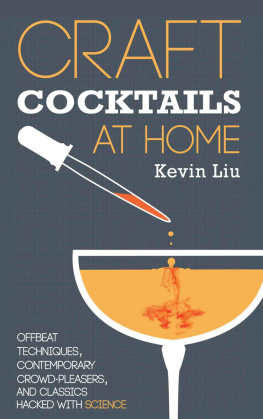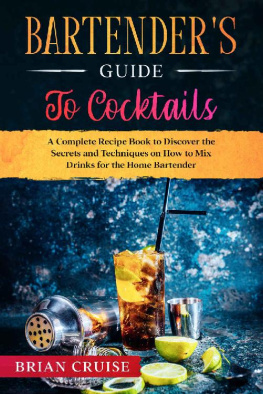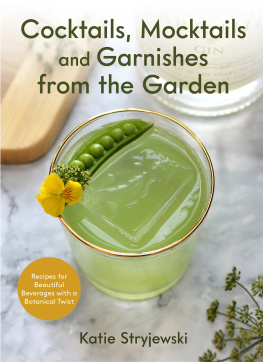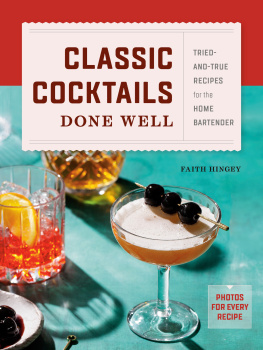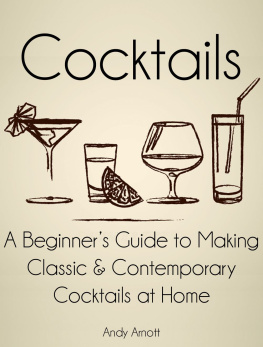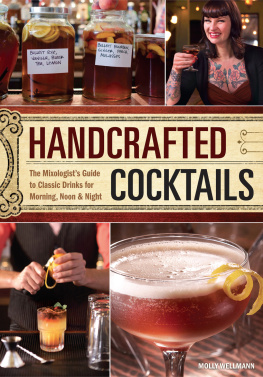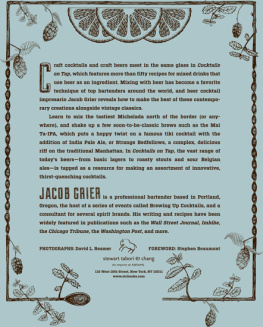Craft Cocktails at Home
Offbeat Techniques, ContemporaryCrowd-Pleasers,
and Classics Hacked with Science
ByKevin Liu
Contents
List of Recipes
List of Interviews
How to Read This Bookand Why Theres No Such Thing as a Craft Cocktail
What is a craft cocktail, exactly? Is a Manhattan a craftcocktail? Sure, if its made with care and properly balanced. But served in aplastic cup with months-old vermouth? Then no, I wouldnt call that a craftcocktail. How about a sugary Pia Colada? Of course not, right? Or maybe yes,since the original version was made with good rum and took months to formulate.
You cant determine whether a cocktail is craft based onits recipe alone. The word craft means that someone has spent the time andattention to create a product worth enjoying. In bartending (as in otherfields), this attention is called mindfulnessmindfulness of how tastes andaromas affect each other, mindfulness of a drinks temperature and dilution,and even mindfulness of a customers mood.
This book began as an attempt to document some of theexciting things happening with cocktails from 2008 to 2012. I was inspired bythe cocktail blog of three PhD students who were thinking about drinks in waysthat completely changed my view of what a cocktail was. As I started doing theresearch for this book, I met others, both online and in person, who shared myobsessions and passions, though not always in relation to cocktails. I realizedthat cocktails are just a vehicle for embracing the mindfulness it takes toexecute any craft.
I hope that you are inspired by some of the ideas in thisbook to explore your own craft, be that origami, fencing, or mixing drinks. Andin case it ends up being the latter, please visit the companion blog to this book to shareyour own experiments and recipes. There, you will find updated links, raw datasets, and summaries of the latest news in cocktail culture.
Start Here
Read this book depending on what you want to get out of it:
If youre just starting out: See the next chapter, and more can be found on the booksblog.
Hackers and makers: Here are the projects youll want totry: theres a multi-purpose temperature controller, a $20 home cold-smoker, anoverkill 1-micron strainer, and a beer-foamer all in the section.
The professional bartender: You, sir or madam, most likelyknow more about classic or craft cocktails than I ever will. I submit only thatyou take a look at the section for some interesting science behind why customers like what theylike. You may also want to browse the list of interviews, since although I amno expert, I managed to convince a few to speak with me.
The devout cocktail geek: Youve probably seen most of theinfo in this book in blogs and forums, so Ive included a special section justfor you: an with dozens of books, papers, and websites for you to explore to your heartscontent. Youre welcome.
Im just here for the buzz: I hear ya, sister. Skip backto the .
Whats Not in this Book
Journalist Malcolm Gladwell writes that it takes 10,000hours to turn a novice into an expert, whether the skill be archery or chess. Aprofessional bartender has the opportunity to create dozens of drinks nightafter night, usually tasting each one. With this experience, she gains theintuition to look at a recipe and simply feel how it will taste.
The home cocktail geek rarelyhas the time or resources to develop this intuition. Since I am not and havenever been a bartender, many of the recipes in this book have not been testedat a bar. Where possible, Ive collected recipes from well-respected bartenderfriends who have been gracious enough to share their creativity.
I cant promise youll like all the ideas and recipes inthis book. But I do think youll find:
The tools and framework youll need to look at a recipe andrecognize whether it will have the flavor profile youre looking for.
Step-by-step instructions on how to create your own signaturecocktail, using only ingredients you already have at home.
The scientific background for why some recipes work and how toimprove others that dont.
Finally, Im intentionally avoiding certain topics, such as centrifugation,rotary evaporation, liquid nitrogen, and distillation because it can costthousands of dollars to apply these techniques properly and if you mess them up,you could do some serious hurt to yourself. Maybe in the next book.
WARNING: DANGER!!!
Ethanol is no joke. Its flammable, its a powerful solvent, anddispensed in excess, it can cause death or at least concentrated stupidity. Usewith caution.
Please do not adapt the techniques in this book to create yourown home distilling rig without first consulting texts specifically written forthat purpose. Done improperly, home-distilled spirits can cause sickness anddeath. Most states in the U.S. do not permit any sort of distillation without apermit.
Although yeasts contribute an important part to the flavor of aspirit, other naturally occurring microbes can produce harmful toxins. See the chapteron preservation for more.
In this book, I advocate the use of some chemicals more oftenused in industry than at home. I have attempted to list specific suppliers andbrands because not all products are food-safe. When a manufacturer says thatsomething is food-grade, they are saying that there are no harmful impuritiesin the product. If in doubt, contact the manufacturer.
Many herbs and spices can be toxic in large quantities. However,to be harmed by any of the botanicals mentioned in this book, you would have tointentionally overdose. Please dont do that.
Please do not consume any undiluted essential or fragrance oils.I recommend a minimum dilution of 1 part essential oil to 100 parts alcohol toproduce an extract that can be used with cocktails. In these concentrations,most essential oils you can buy are considered Generally Recognized as Safe(GRAS) by the U.S. Food and Drug Administration (FDA).
Authors Note
Parts of this book have been adapted from posts thatoriginally appeared on http://craftcocktailsathome.comand http://sciencefare.org.
Some of the links in this book are bulky. In some cases,Ive referred to a website without providing a full URL because I assume youwill be able to find your way there. In either case, you can visit the blog forfull URLs, they will be posted and updated there. Similarly, citations do notfollow a rigorous format because this is not a scholarly work. If unclear, fullcitations may be requested through the blog.
This book was written and researched in the United States;as such, recommendations for where to buy tools and ingredients are based onwhats available in this country. I would love to hear from you if you areoutside the States and have recommendations specific to your region of theworld. Contact information will be updated on the books blog.
For more thoughts from me, .
Down the Rabbit Hole: How to Mix Your First Drink
Ill admit: Im targeting this book at people who arealready enamored with cocktails and want to learn more about whatdifferentiates a good drink from a great one. But if youve never mixed a drinkin your life and just want to know how to get started, dont worry: Ive gotyou covered.
The below recommendations will set you on the right trackfor a minimal investment. And Im talking really minimal. If yourelooking for some more standard recommendations, check out the section on at the end of the book.
Really Basic Tools
I regret to admit I have used every one of these tools, atsome time or another

Next page
